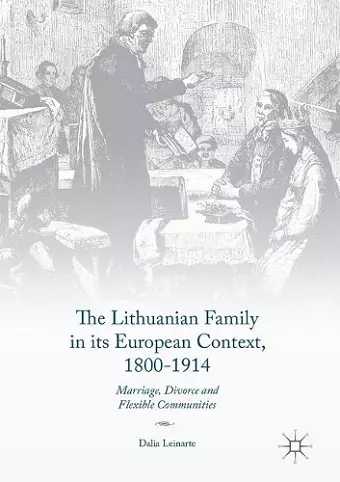The Lithuanian Family in its European Context, 1800-1914
Marriage, Divorce and Flexible Communities
Format:Hardback
Publisher:Springer International Publishing AG
Published:26th Jun '17
Currently unavailable, and unfortunately no date known when it will be back

"Leinarte's book...is a pioneering effort to structure a very complex data set of primary sources... dealing with family, marriage, divorce, and related topics. In western scholarship, the field of "family history" (inclusively defined) has been a standard part of social-history research since the 1960s, but not so in or about the Baltic region. The inherent complexity of the project ensures a long shelf-life for the book: Leinarte has no competitors in this field in the Lithuanian profession, and this is true also among western researchers." (Andrejs Plakans, Iowa State University, USA)
This case study reveals how under often restrictive laws and policies – serfdom up to 1861, and the pervasive role of the Church, in addition to deep-rooted customary practices – women and men manage to normalize their family life.This book investigates marriage and divorce in the nineteenth-century European territories of the Russian Empire. It uncovers the way a peasant community employed unsanctioned marital behaviour, such as cohabitation and bigamy, among others, in order to respond to the external factors that had an impact on the family life, including transmission of inheritance and household structure. Lithuania was part of the Tsarist Empire until 1914. This case study reveals how under often restrictive laws and policies – serfdom up to 1861, and the pervasive role of the Church, in addition to deep-rooted customary practices – women and men manage to normalize their family life. The volume is based on a wide range of archival sources and uncovers familial behaviour both from an individual and community perspectives.
This book was awarded the AABS Book Prize Honorable Mention 2018 by The Association for the Advancement of Baltic Studies (AABS).
“In its consideration of this book, the committee described it as “distinguished by the methodological diversity. [Parts of the book] present a microscopic view evaluating the subjective range of motives and perceptions of intelligentsia or peasants. At the same time, quantitative data and structural analyses are present…reconstructing long-term developmental tendencies.”” (AABS The Association for the Advancement of Baltic Studies, aabs-balticstudies.org, August 12, 2018)
“By using an exhaustive number of studies by eastern and western European scholars, she has updated and given the Lithuanian family a place on a spectrum of the stereotypically progressive Western, and the backward Eastern, European family. … The substance and originality of this work are important for scholars engaged in comparative studies … . This work will no doubt remain the definitive work on the Lithuanian family of the nineteenth and early twentieth century for a long time.” (Virgil I. Krapauskas, Journal of Baltic Studies, Vol. 49 (03), July, 2018)
ISBN: 9783319510811
Dimensions: unknown
Weight: 3846g
192 pages
1st ed. 2017